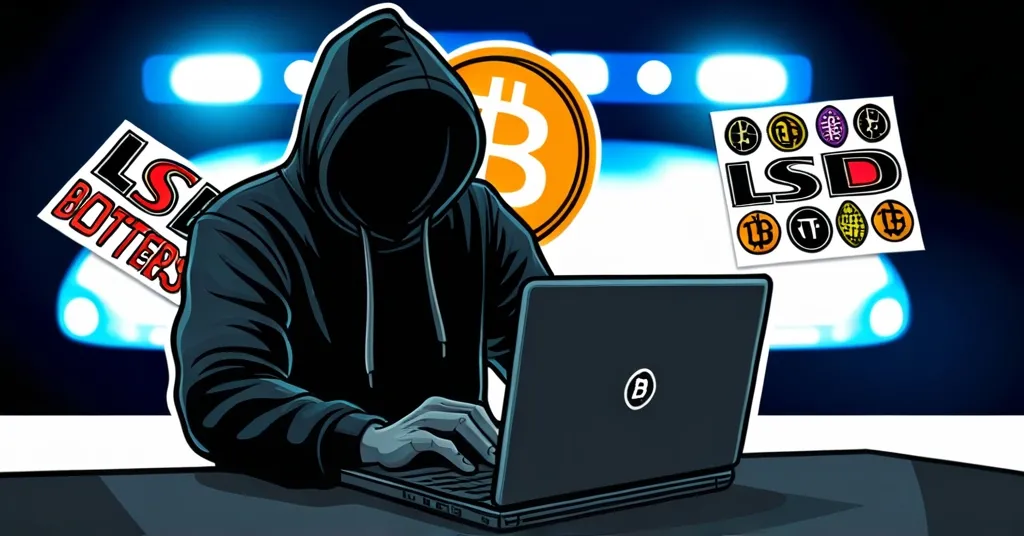Indian Photographer Busted for Buying LSD with Bitcoin on Dark Web

Photographer’s Dark Web Deal: The Bitcoin and LSD Connection
What happens when a photographer’s lens focuses on the dark side of the digital economy? Mohammed Shahbaz, a 27-year-old photographer from Kolkata, was arrested in Gurugram, Haryana, on February 19, 2025, for using cryptocurrency to purchase LSD, disguised as children’s tattoo stickers, with the intent to distribute at high-profile parties. This case underscores the complex interplay between cryptocurrencies, the dark web, and illegal drug trade, raising urgent questions about the need for regulatory oversight.
- Indian photographer arrested for buying LSD with cryptocurrency
- LSD disguised as children’s tattoo stickers
- Purchased via dark web site Bioness using Tor browser
- Highlights need for stronger regulation of cryptocurrencies
The Arrest
Mohammed Shahbaz was apprehended by the Anti-Narcotics Cell in Gurugram after purchasing 2.7 grams of LSD from the dark web site Bioness. The LSD was cleverly disguised as children’s tattoo stickers, a method designed to evade detection by scanners. Shahbaz, who had been working as a photographer in Delhi, used cryptocurrency to maintain his anonymity during the transaction. This anonymity is facilitated by tools like the Tor browser, which allows users to access the dark web, a hidden part of the internet not indexed by conventional search engines, often used for illegal activities.
An FIR was filed against Shahbaz under Section 22(c) of the NDPS Act (the Narcotic Drugs and Psychotropic Substances Act of India) at Sushant Lok police station, and he was remanded to four days of police custody. Sub-Inspector Karamjit, overseeing the case, stated,
“Shahbaz has been working as a photographer in Delhi for the past year. He has been remanded to four days of police custody, and we are questioning him about his international connections.”
The Dark Web Connection
The dark web, accessible through the Tor browser, provides a platform for anonymous transactions, which has been exploited for drug trafficking and other criminal endeavors. Shahbaz’s case is not isolated; it reflects a global trend of using the dark web for illegal drug transactions. For instance, the case of Rui-Siang Lin, who operated the Incognito Market, highlights how these platforms facilitate the sale of illegal substances using cryptocurrencies. Acting U.S. Attorney Edward Y. Kim described Incognito Market as a “prolific online narcotics bazaar” that exacerbated the opioid and fentanyl crisis, illustrating the severe impact of such marketplaces on public health and safety.
LSD use is on the rise in India, mirroring trends in the US, Russia, and Europe. An official connected to Shahbaz’s case noted,
“LSD is widely used in the US, Russia, and European countries, and we are seeing a rising trend in India as well.”
This growing trend at rave parties underscores the need for vigilance in monitoring the dark web and the use of cryptocurrencies for illegal activities.
Regulatory Implications
Union Home Minister Amit Shah has emphasized the challenges posed by the dark web, cryptocurrency, and drones in combating drug trafficking in India. He noted a significant increase in drug seizures over the past decade, indicating heightened efforts to tackle this issue. The Indian government, under Prime Minister Narendra Modi, has adopted a zero-tolerance policy against drug trafficking and is implementing a three-pronged strategy to achieve a drug-free India by 2047. This includes strengthening institutional frameworks, enhancing coordination among narcotics agencies, and launching public awareness campaigns.
The economic scale of the drug trade in India is staggering, with the Narcotics Control Bureau and police across the country seizing drugs worth ₹16,914 crore in 2024 alone. This underscores the government’s commitment to tackling the issue head-on. The conference on ‘Drug Trafficking and National Security’ highlighted the need for technological solutions to combat the use of the dark web and cryptocurrencies in drug trafficking, suggesting potential future measures to curb such activities.
The Indian government’s efforts to regulate cryptocurrency in the context of the dark web drug trade are crucial, as noted in discussions about cryptocurrency regulation.
Counterpoints and Broader Context
While the potential of cryptocurrencies to disrupt traditional financial systems and promote financial freedom is undeniable, cases like Shahbaz’s serve as a sobering reminder of the technology’s potential for misuse. The balance between fostering innovation and preventing criminal exploitation remains a delicate one, requiring thoughtful and robust regulatory frameworks. As we continue to advocate for the benefits of decentralization and effective accelerationism, it’s crucial to address these challenges head-on to ensure a safer and more transparent future for all.
Bitcoin, often seen as the leading cryptocurrency, is frequently viewed as a safer haven compared to other cryptocurrencies used in illegal activities. While Bitcoin’s blockchain provides a level of transparency that can aid law enforcement in tracking transactions, the broader crypto ecosystem plays a role in the financial revolution, filling niches that Bitcoin itself may not serve well.
The question of how to regulate cryptocurrencies to prevent their use in illegal activities is a complex one, as discussed on Quora.
Key Questions and Takeaways
What was the suspect arrested for?
Mohammed Shahbaz was arrested for purchasing LSD using cryptocurrency and intending to distribute it at high-profile parties in Gurugram.
How did the suspect obtain the drugs?
Shahbaz obtained the LSD from the website Bioness, accessible via the Tor browser, and paid for it using cryptocurrency.
What form did the drugs take?
The LSD was disguised as children’s tattoo stickers, designed to evade detection by scanners.
What legal actions were taken against the suspect?
An FIR was filed against Shahbaz under Section 22(c) of the NDPS Act, and he was remanded to four days of police custody.
What broader implications does this case have for cryptocurrency regulation?
The case highlights the need for enhanced regulatory oversight of cryptocurrencies to prevent their use in illegal activities on the dark web, such as drug trafficking and funding terrorism.
The impact of the dark web on drug trafficking is a significant concern, as detailed in a UN report.
Shahbaz thought he was snapping pictures, but he inadvertently captured the attention of law enforcement. As we navigate the complexities of cryptocurrencies, it’s essential to maintain a balanced perspective, recognizing both their revolutionary potential and the challenges they pose.



